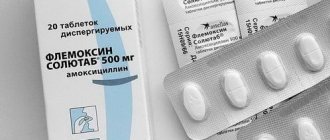Description of the drug MONTELUKAST
The effectiveness of oral montelukast for the treatment of acute attacks of bronchial asthma has not been established. Therefore, oral montelukast is not recommended for the treatment of acute attacks of bronchial asthma. Patients should be instructed to always carry emergency medications to relieve asthma attacks (short-acting inhaled beta2-agonists).
You should not stop taking montelukast during an exacerbation of asthma and the need to use emergency medications (short-acting inhaled beta2-agonists) to relieve attacks.
Patients with a confirmed allergy to acetylsalicylic acid and other NSAIDs should not take these drugs during treatment with montelukast, since montelukast, while improving respiratory function in patients with allergic bronchial asthma, nevertheless cannot completely prevent bronchoconstriction caused by NSAIDs.
The dose of inhaled corticosteroids used simultaneously with montelukast can be gradually reduced under the supervision of a physician, however, an abrupt replacement of inhaled or oral corticosteroids with montelukast cannot be carried out.
Neuropsychiatric disorders have been described in patients taking montelukast. Given that these symptoms could be caused by other factors, it is unknown whether they are related to montelukast. Physicians should discuss these side effects with patients and/or their parents/guardians. Patients and/or their caregivers should be advised that if such symptoms occur, they should notify their physician.
Reducing the dose of systemic corticosteroids in patients receiving anti-asthmatic drugs, including leukotriene receptor blockers, was accompanied in rare cases by the appearance of one or more of the following reactions:
- eosinophilia, rash, worsening pulmonary symptoms, cardiac complications and/or neuropathy, sometimes diagnosed as Churg-Strauss syndrome, systemic eosinophilic vasculitis. Although a causal relationship between these adverse reactions and leukotriene receptor antagonist therapy has not been established, caution and appropriate clinical monitoring should be used when reducing the dose of systemic corticosteroids in patients receiving montelukast.
Use in pediatrics
Montelukast should not be used in children under 2 years of age.
In children over 2 years of age, montelukast should be used in the appropriate dosage form.
It is known that any impact that causes instability and destruction of cell membranes (infection, allergies, cold, heat, irritants and toxicants, changes in pH) causes inflammation, the mediators of which are leukotrienes. Leukotrienes have a powerful pro-inflammatory effect: they increase phagocytosis, infiltration of the mucous membrane with granulocytes, cause swelling, hypersecretion of mucus, and bronchospasm.
Montelukast relieves eosinophilic and neutrophilic inflammation due to its ability to nonspecifically inhibit cyclic nucleotide phosphodiesterases and cAMP-dependent suppression of the proinflammatory activity of neutrophils. Thus, the access of leukotrienes to the cysteinyl receptors of neutrophils is blocked.
It is known that children with allergic diseases and a hereditary predisposition to them are more likely to suffer from acute respiratory viral infections (ARVI); they are more often diagnosed with mixed-associated viral infections and deficiency of interferon production. A number of studies have demonstrated that the use of antileukotriene drugs is especially indicated for bronchial asthma (BA) provoked by ARVI.
According to numerous scientific publications, montelukast prevents bronchospasm, has a bronchodilator effect, reduces the severity of symptoms of bronchial asthma, including cough, improves lung function, reduces hyperreactivity and severity of inflammation in the airways, and reduces the frequency of exacerbations of bronchial asthma. For mild asthma, montelukast is successfully used for basic treatment as monotherapy.
There is evidence that in case of obstructive syndrome due to mycoplasma infection, the addition of montelukast to specific antibacterial therapy was effective. Montelukast has been proven effective in the treatment of recurrent bronchitis and chronic cough.
In acute respiratory viral infections, the cytopathic effect of viruses leads to the destruction of cell membranes and the launch of inflammation mechanisms and the synthesis of leukotrienes in the body. It is quite understandable that, according to foreign authors, montelukast reduced bronchial obstruction in young children suffering from acute respiratory viral infection with obstructive syndrome. Abroad, sufficient experience has already been accumulated in the use of montelukast for recurrent obstructive bronchitis in children of early and preschool age. An interesting opinion of foreign experts is that, as a rule, under the guise of recurrent obstructive bronchitis, timely unrecognized BA is hidden.
It should be noted that the symptom complex, which in Russia is interpreted as recurrent (obstructive) bronchitis, has long been designated abroad as bronchial asthma provoked by acute respiratory infection (ARI). At the same time, the possibility of use for recurrent obstructive bronchitis is not included in the instructions as an indication for the use of monteclukast in our country.
Of particular interest is evidence that montelukast may reduce the likelihood of cytokine storm development during COVID-19 infection. This sensational finding of the possible direct antiviral activity of montelukast, along with its anti-inflammatory (anti-leukotriene) effect, opens up new prospects for its use.
In conclusion, the authors conclude that there is a strong rationale for the treatment of obstructive bronchitis and bronchial asthma in children of early and preschool age with the drug montelukast.
It should be emphasized that no clinically significant side effects have been reported with the use of montelukast. Montelukast is approved for use in children over 2 years of age.
Source: Mizernitsky Yu.L. Pathogenetic rationale for the use of montelukast (Singlon) for acute respiratory viral infections with broncho-obstructive syndrome in infants and preschool children. Ros Vestn Perinatol and Pediatrician 2020; 65:(6): 129–132. DOI: 10.21508/1027–4065–2020–65–6–129–132
results
In the WHO global registry, the most common adverse effect was depression (odds ratio (OR), 6.93; 95% CI, 6.5–7.4). Among children, the most common adverse effect was aggressive behavior (OR, 29.77; 95% CI, 27.5–32.2).
- In the Dutch database, the most common adverse effect was headache, both among adults (OR, 2.26; 95% CI, 1.61–3.19) and children (OR, 3.18; 95% CI, 2.66-3.70).
- It should be noted that frequently reported side effects also included nightmares in children and adults.
- The Dutch registry reported 8 cases of eosinophilic granulomatosis with polyangiitis, while the WHO registry reported 563 cases. The authors of the publication emphasize that the connection between taking montelukast and Churg-Strauss syndrome is not completely clear and further analysis of cases is required.
Source:
Pharma Res Per. Published online September 20, 2022.
Montelukast drives patients to suicide
The US Food and Drug Administration (FDA) has raised serious concerns about the safety of montelukast, a popular drug known under the brand name Singulair and used in children and adults for preventive and chronic treatment of asthma. to prevent exercise-induced bronchospasm, as well as to relieve symptoms of seasonal and persistent allergic rhinitis. The regulator believes that doctors and patients underestimate the dangers of the risks posed by montelukast, which are associated with adverse reactions from mental health, including suicidal thoughts or actions.
The existence of a certain likelihood of developing neuropsychiatric disorders outweighs the benefit that montelukast can bring. And so the FDA insists that doctors be more reserved and cautious about prescribing treatment with montelukast. This is especially true if the symptoms of the disease are mild, and the disease itself is quite amenable to treatment with other drugs.
For example, in the case of allergic rhinitis, also known as hay fever, montelukast should be left as a reserve drug, prescribed only after other drugs have failed or are intolerable. Among the wide range of these are: antihistamines loratadine, fexofenadine, cetirizine, levocetirizine, diphenhydramine and steroid intranasal sprays fluticasone, triamcinolone, budesonide. Don't forget about allergen-specific immunotherapy.
In most cases, mental health symptoms were observed during montelukast therapy and resolved upon discontinuation of the drug. However, there have been cases of neuropsychiatric disorders that manifested or persisted even after discontinuation of montelukast. All of the above is true for patients both with a history of mental illness and without previously existing mental disorders.
The problems with montelukast associated with its negative impact on the psyche were first revealed back in 2008. And now, due to the continuing increase in the number of cases of psychoneurological disorders, we can safely say that there is a direct connection with the use of Montelukast.
You should stop taking Montelukast immediately if you experience any changes in behavior or mood. Among such signal changes:
"Glemont" , "Glenmont".
Delpomont, Denverkast, Denk-Air, Dilair, Diffalon, Diuk Lafrancol, Duramont (Duramont).
"Zakomoxit", "Zespira", "Zylcas".
"Idulair", "Easyast", "Ezevent", "Inhalst", "Inletair", "Inmunobron", "Inmunocast", " Inspirol, Inspra, Inuvik.
"Yekast"
“Capturan”, “Kast”, “Kastair”, “Kastel”, “Kastol”, “Kastorion”, “Castispir”, “Kemtelo” "(Kemtelo), "Kipres", "Clast/Klast ", "Clear Air", "Kokast", "Conkast", "Croma" , “Xalar”, “Xigenast”, “Ximprove”, “Xyflo”, “Kulair”, “Culento”, “Curost”.
"Lanair", "Lungair", "Lasma", "Lelipel", "Leukast", "Leucotren", "Leukotris", " Liam, Loctril, Lukavent, Lukair, Lukakline, Lucamont, Lukanex, Lucaratio "(Lukaratio), "Lukas" (Lukas), "Lukasm" (Lukasm), "Lukasma" (Lukasma), "Lukast" (Lukast) , "Lukastang", "Lukastin" (Lukastin) , "Lukas ( Lukema), Luxat, Lulast, Lumenta, Lumona, Lumont.
"Maxair", "Medikast", "Medlukast", "Melarth", "Meflort", "Miletic", "Milukante" , " Minair, Mingair, Mintalos, Miralust, Myteka, M-Kast, M-Lucas (M-Lucas), "Modrian", "Modular", "Mogulair", "Mokast", "Molicust", "Molly", "Molukar" "(Molucar), "Molukat", "Molus", "Mon", "Monaka", "Monax", " Monalast ", "Monalux" (Monalux), "Monark", "Monas", "Mondeo", "Moneka", "Monekast", "Monk", "Monkas" ( Moncas), "Monkast", " Monkasta", "Monkon" , "Monk-P", "Monxe", "Monlast", " Monler , Monlucare, Monovas, Monocast, Monolair, Monofast, Monprox, Monsefil "(Moncefil), "Monstonol", "Montair", "Montal", "Montalis", "Monthan", "Montas", "Montasma" (Montasma), "Montast", "Montegen", "Montegol", "Montedor", "Montezyd", "Montezim", "Montail" ( Montale), "Montec" (Montec/Montek), "Monteka" (Monteka), "Montekal" (Montekal), "Montekast" (Montekast), "Montecon" (Montecon), "Montex", "Montexal" (Montexal), “Montexin”, “Montel”, “Montela” , “Montelair” (Montelair/Montelar) , “Montelast” , “Montelex”, “Montelo” "(Montelo), "Montelon", "Montelubronch", "Montelugen", "Monteluk", "Montelukast" (Montelukast/Montelucast/Montelucaste), "Montelukastum" , Montelus, Monteluteg, Montelux, Montemac /Montemak, Montemax, Montemed , Montene ), "Montena", "Montenaaf", "Montenuzyd", "Montep", "Monte -R" , "Monterin", "Monteron" "(Monteron), "Montespir", "Montessan", "Montest", "Montesur", "Montetrinas", "Montefar", "Montescher" (Montesher), "Monte-Air", "Monti" (Monti/Monty/Montey), "Montiva", "Montiget", "Montica/Montika", " Montilab, Montilak, Montilet, Montipedia, Montifast, Montol, Mont-R ), "Montrate", "Montril", " Montular", "Montulind" , "Mont-heim", "Monukast", "Moor" "(Moor), "Montemak", "Monchr", " Moral" , "Moscalair", "Moteqi", "Mofenstra", "Mukosoft" (Mucosoft), “Mulpas” (Moolpas), “Multiler” (Multiler), “Mooncast”.
“Nozma”, “Notta”, “N-Fess”.
"Odimont", "Odmon", "Orilukast", "Otelus".
"Piemonte", "Plenair", "Pluralais", "Pneumo-Kast", "Primeair", "Prevenil", "Provair" ( Provair), Promonta, Profilax, Pulmokast, Pulmont.
“Reversair”, “Recast”, “Relukas”, “Reokast”, “Respair”, “Respikast”, “Riskal”, “ Rolast, Romilast.
"Sansibast", "SB-Monec", "Sedokast", "Selezen", "Senloir", "Senovital", "Silmon" ( Silmon), Singukast, Singulex, Sincast, Simplaer, Sinair , Sinbrux, Singlon /Synglon) , “Singodem”, “Singulex” Singulair” , “Singument-S”, “Sin-Mont”, “Sintair” (Sintair), “Sintelukast-Humanity”, “Sintrine”, “Smarti”, “Speradac”, “Spirokast”, “Spiromon”, "Surfair", "Suviar", "Symlukast".
Take Air, Tekast, Telekast, Teluk, Teluka, Telukast, Telumantes , Telumyl, Terrakast, T Lukast, Topraz, Thordel, Trilucky, Trilock ).
"Urilast" (Urilast).
Flomont, Freegest, Fulmont.
"Centokast", "Cerrokast".
"Everest", "Edron", "Airbron", "Airway", "Airfast", "Aireez", "Aireal", " Airing, Aircast, Airlast, Airlukast, Airmol, Airokast, Airomed, Airon "(Airon), "Airfix", "Ektalust" , "Elukan", "Elunkast", "Emlucast", "Eonic", "Efira" (Ephyra).
Unicast, Uniair.

